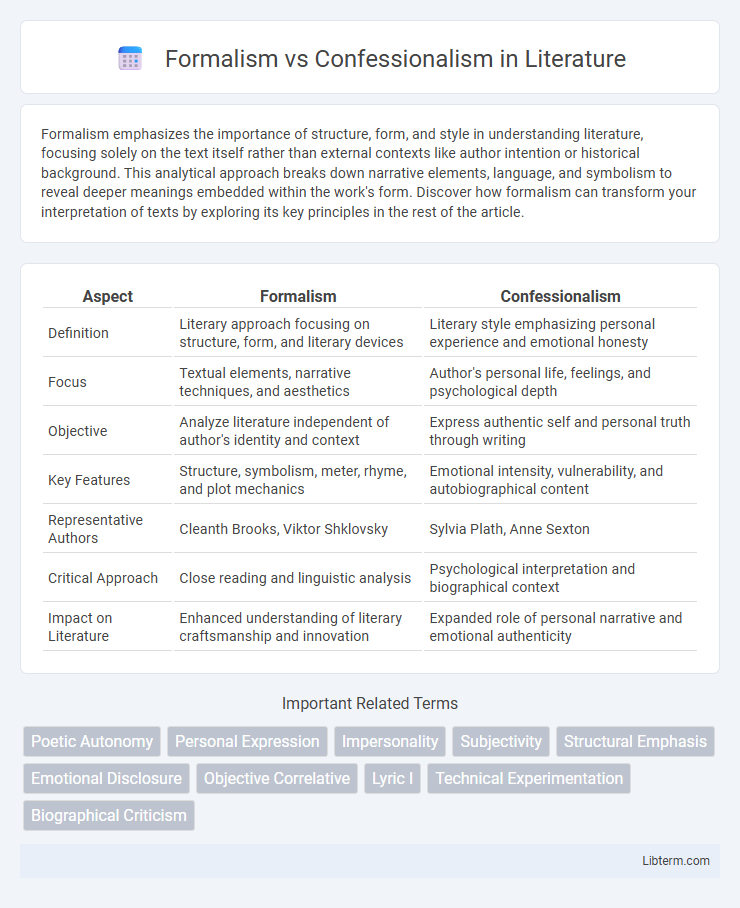Formalism emphasizes the importance of structure, form, and style in understanding literature, focusing solely on the text itself rather than external contexts like author intention or historical background. This analytical approach breaks down narrative elements, language, and symbolism to reveal deeper meanings embedded within the work's form. Discover how formalism can transform your interpretation of texts by exploring its key principles in the rest of the article.
Table of Comparison
| Aspect | Formalism | Confessionalism |
|---|---|---|
| Definition | Literary approach focusing on structure, form, and literary devices | Literary style emphasizing personal experience and emotional honesty |
| Focus | Textual elements, narrative techniques, and aesthetics | Author's personal life, feelings, and psychological depth |
| Objective | Analyze literature independent of author's identity and context | Express authentic self and personal truth through writing |
| Key Features | Structure, symbolism, meter, rhyme, and plot mechanics | Emotional intensity, vulnerability, and autobiographical content |
| Representative Authors | Cleanth Brooks, Viktor Shklovsky | Sylvia Plath, Anne Sexton |
| Critical Approach | Close reading and linguistic analysis | Psychological interpretation and biographical context |
| Impact on Literature | Enhanced understanding of literary craftsmanship and innovation | Expanded role of personal narrative and emotional authenticity |
Introduction to Formalism and Confessionalism
Formalism emphasizes structured analysis, prioritizing text, form, and stylistic elements over authorial intent or historical context. Confessionalism centers on the personal experiences, emotions, and subjective truths of the author, often revealing intimate, autobiographical elements within the work. Both approaches shape literary interpretation by either isolating the text itself or intertwining it with the creator's personal narrative.
Defining Formalism: Key Principles and Features
Formalism emphasizes structured, rule-based analysis prioritizing form, technique, and intrinsic elements within a work of art or literature, disregarding external contexts such as author intent or historical background. Key principles include close reading, examining narrative structure, symbolism, and stylistic devices to reveal meaning embedded within the text itself. Formalism features an objective, systematic approach that treats the work as a self-contained entity, advocating for the interpretation solely grounded in its formal properties.
Understanding Confessionalism: Core Concepts
Confessionalism emphasizes the integration of personal religious beliefs into political governance, prioritizing sectarian interests to maintain social stability and power-sharing among religious groups. This approach contrasts with formalism, which relies on procedural rules and legal frameworks without necessarily addressing underlying religious or cultural divisions. Understanding confessionalism involves recognizing its role in managing pluralistic societies by institutionalizing representation based on religious affiliation, often seen in countries like Lebanon and Belgium.
Historical Origins and Development
Formalism in theology originated in the late 19th century as a reaction to liberal theology, emphasizing strict adherence to established doctrines and church traditions. Confessionalism developed concurrently, particularly within Protestantism, as a movement affirming detailed doctrinal statements such as the Augsburg Confession to maintain theological clarity and unity. Both approaches evolved through historical disputes like the Reformation and Enlightenment, shaping denominational identities through their differing commitments to dogmatic formulations versus personal faith expression.
Main Proponents and Influential Figures
Formalism in literature is championed by figures like Viktor Shklovsky and Roman Jakobson, who emphasize the importance of literary devices and structure over content or author biography. Confessionalism, prominently associated with poets such as Sylvia Plath, Robert Lowell, and Anne Sexton, prioritizes personal experience and emotional honesty, often exploring themes of trauma and mental illness. These influential figures shaped their respective movements by focusing on either the artistic form or the intimate revelation of the self.
Formalism in Literature and Art
Formalism in literature and art emphasizes the intrinsic features of a work, such as structure, style, and form, rather than external contexts like author biography or historical background. This approach analyzes elements like narrative techniques, symbolism, and composition, prioritizing how these components create meaning independently of external influences. Key formalist theorists include Viktor Shklovsky, Roman Jakobson, and Cleanth Brooks, who advocate for close reading and detailed examination of artistic devices.
Confessionalism in Literature and Art
Confessionalism in literature and art centers on intimate, autobiographical expression, revealing personal truths and psychological depth. Writers like Sylvia Plath and Robert Lowell use confessional techniques to expose raw emotions and life experiences, challenging traditional formal structures. This movement contrasts with Formalism by prioritizing emotional authenticity and subjective experience over strict adherence to form and technical rules.
Comparative Analysis: Strengths and Weaknesses
Formalism offers a structured, objective approach to interpretation and decision-making, emphasizing rules and consistency, which enhances predictability in legal and literary contexts. Confessionalism fosters deep personal insight and authenticity by valuing individual experience and emotion, though it risks subjective bias and inconsistency. The comparative strength of formalism lies in its universality and replicability, while confessionalism excels in providing nuanced, context-sensitive understanding, with weaknesses rooted in rigidity and potential for relativism, respectively.
Contemporary Relevance and Debates
Formalism emphasizes strict adherence to established structures and rules in art or literature, contrasting with Confessionalism's focus on personal experience and emotional expression. Contemporary debates center on the relevance of Formalism in an era valuing authenticity and vulnerability, while Confessionalism faces scrutiny over subjectivity and potential self-indulgence. The ongoing discourse highlights tensions between objective craftsmanship and individual narrative in modern creative practices.
Conclusion: The Ongoing Influence of Both Approaches
Formalism and Confessionalism continue to shape literary criticism by emphasizing structure and authorial intent respectively, fostering diverse analytical perspectives. Formalism's focus on text-intrinsic elements promotes close reading techniques that reveal intricate patterns and meanings within the work itself. Confessionalism prioritizes the author's personal experiences and psychological background, enriching interpretations through biographical context, ensuring both approaches remain vital to contemporary literary analysis.
Formalism Infographic

 libterm.com
libterm.com